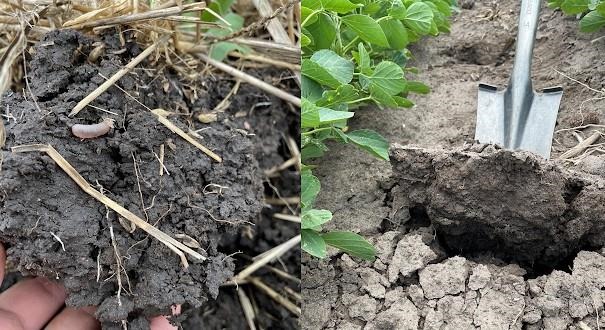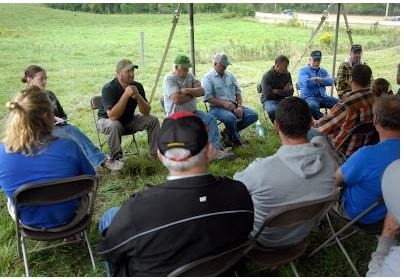By Bailey Tangen and Anna Cates

Signs of a healthy ecosystem in the field with soil health management (left), compared to signs of crusting and compaction in the plowed field (right).
Climate change is projected to change the timing, frequency, and severity of spring precipitation in Minnesota, and farmers might notice those changes first. Increases in the number and quantity of rains are expected early in the growing season in Southern Minnesota, where acres of corn and soybean dominate the landscape. Besides increasing the risk of water erosion in these fields, erratic rain patterns cause a lot of stress to farmers looking to plant corn and soybeans in May.
“Weather has always been unreliable, but the extreme weather throws us for a loop. I still remember a really wet year in the early 80s where we planted on April 28th and didn’t get wheels in the field until June 6th, because of all of the rain,” remembers Mark Ditlevson, a Steele county farmer. “There’s no set rule anymore… I suppose,” Rice county farmer Larry Salaba commented.
And though water is critical for plant growth, raindrops are destructive. Raindrops can hit the soil surface at 20 miles per hour, dislodging particles 3-5 feet into the air. The raindrops weaken the structure of the soil and pores get clogged. These pores are like the pipes in your house - if the pipe gets blocked, nothing will drain, keeping the soil waterlogged. Water flowing across the weakened soil surface carries sediment, organic matter, and excess nutrients away from fields, deteriorating the soil over time.
In the short term, farmers can’t drive equipment on wet fields, or they risk getting their tractors stuck or compacting their fields. Delaying planting can reduce yields, causing plenty of stress around rural Minnesota.
Farmers who use soil health practices such as reducing disturbance and keeping living roots in the ground are likely to increase the organic matter and stabilize the soil in their fields. When these farmers claimed that they were able to get their fieldwork done on time because they could drive on their soils more quickly after a rain than conventional neighbors, University of Minnesota researchers were eager to investigate. “We tried to understand how the soil responded to rain under different management,” said Dr. Anna Cates, Extension soil health specialist. “Were soil health practices preventing that structural breakdown as soil was saturated?”

At a September 2022 field day in Rice county, farmer
cooperators shared how they managed the logistics
of their farm operations
The study, funded by a Watershed Innovation Grant from the U of M's Water Resources Center, examined how soil moisture and structure change after rainfall with different farming practices. Researchers studied plots at the Southern Research and Outreach Center in Waseca for controlled comparisons, as well as from paired farm sites in Rice and Steele counties. After two dry field seasons, results so far showed that reducing tillage could increase soil stability on farms, but the response to rain was similar across treatments. Soils under different tillage and cover crop regimes captured similar amounts of water during rain events and aggregate stability generally increased across the growing season regardless of management.
Farmers using soil health practices are still convinced differences show up in the soil. “Since switching from chisel plow to no till, I have seen my fields gaining soil structure, so they are stronger and able to hold up the equipment,” says farmer Mark Ditlevson. The project also includes an ongoing survey, which explores not only when field work occurs in different systems, but how that affects farmer mental health and quality of life. Rural stress is a grave concern in agricultural communities across America, so impacts on farmer mental health is an important aspect of different farm systems.
Going forward, the research team will continue to analyze data, modeling soil water behavior over the course of the season as well as farmer stress. The farmer collaborators will be watching the forecast this spring, hoping for dry- but not too dry- planting conditions.
Source : umn.edu